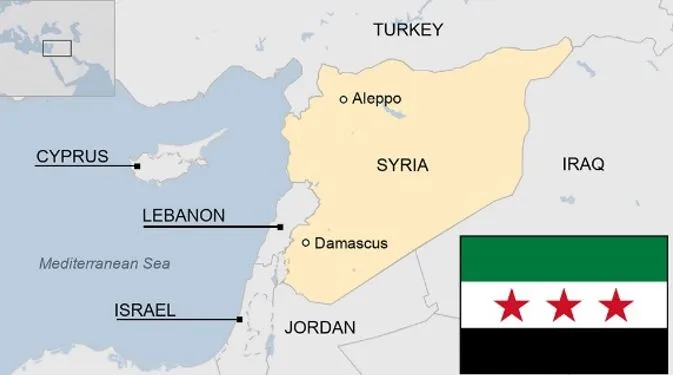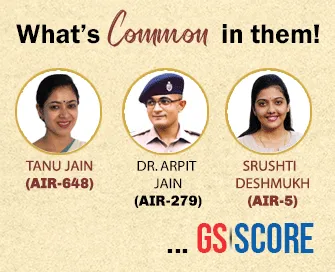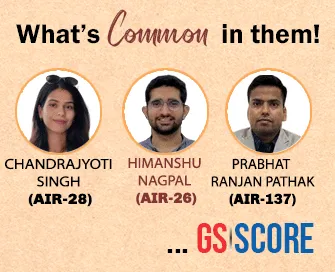

17th May 2025 (9 Topics)
Mains Issues
Context
US President Donald Trump visited Saudi Arabia, Qatar, and the UAE, where he announced the lifting of 46-year-old US sanctions on Syria. This marked a dramatic policy shift, especially since Syria's new leader, Ahmed al-Sharaa, is a former al-Qaeda affiliate once targeted by the US.
Brief Background
- The US imposed sanctions on Syria in 1979 after it was designated a State Sponsor of Terrorism, especially for supporting Palestinian and Lebanese armed groups.
- These sanctions intensified over the years:
-
- 2004: Added economic and defense restrictions.
- 2011–2019: After Syria’s civil war began, sanctions became comprehensive, targeting oil, finance, and state-linked individuals (like Assad) under the Caesar Act.
- Now, Trump plans to revoke most of these, starting with those under executive orders.
Why the US is Changing Course on Syria?
- Change of Leadership Justifies Policy Shift: The primary reason Trump could justify lifting sanctions is that Bashar al-Assad has been removed. Since US sanctions were tied to Assad’s regime—due to human rights abuses, war crimes, and support to terrorist groups—the exit of Assad provides a technical and symbolic opening.
- Al-Sharaa, who led a coalition that ousted Assad, now heads a “transitional administration”.
- Though his past links with al-Qaeda are serious, Trump has decided to ignore this history, focusing instead on realpolitik and “regional ownership” of stability.
- Moderation & Stability in Syria: Al-Sharaa’s government is being presented as more moderate and pragmatic:
- He has unified sectarian militias, integrated them into the national military, and avoided overt ideological posturing.
- He is also open to international cooperation, including potentially recognizing Israel through the Abraham Accords and working to suppress ISIS.
- This makes it easier for the US and allies to engage Syria— sanctions have done their job in pushing out Assad and creating space for a relatively stable government.
What is US’s Middle East Vision?
- Shift from Military to Economic Engagement: Trump’s approach in the Middle East is less about democracy promotion or military intervention, and more about economic deals. He emphasized “regionally-owned” conflict resolution, signaling US disengagement from ground conflicts like Syria and Iraq. Instead of promising aid or military presence, he wants:
- Syria to handle its own reconstruction (with help from Gulf states).
- Al-Sharaa to assist in containing ISIS and policing extremist groups.
- Massive Trade Deals with Gulf States: Trump's visit produced USD 1 trillion in combined deals:
- USD 600 billion with Saudi Arabia, including a record USD 142 billion arms deal.
- USD 243.5 billion with Qatar.
- USD 200 billion with the UAE.
- In return, the Gulf states are:
- Investing in the US economy.
- Offering Trump personal favors (e.g., Qatar gifting a custom Air Force One jet, real estate deals).
- Engaging with key Trump allies, like Elon Musk, who is helping Saudi Arabia integrate Starlink for digital expansion.
- Emerging Minilateralism: Trump continues to push for groupings like the I2U2 (India-Israel-UAE-USA) which emphasise economic and technological collaboration rather than military alignment.
- His call for Syria to join the Abraham Accords may be part of a larger effort to reshape regional alliances into more transactional, economically-driven platforms.

What about Israel?
- Israel’s Discomfort: Israel, under Prime Minister Netanyahu, opposes lifting sanctions on Syria, viewing it as empowering a potential threat near its border. It also worries about US re-engagement with Turkey and Iran.
- Turkey is being allowed back into the F-35 fighter jet program (after being removed for buying Russian weapons).
- The US recently approved a USD 304 million missile deal with Ankara.
- Talks with Iran: Most controversially, Trump said the US and Iran are close to a new nuclear deal. Iran appears ready to trade its enriched uranium stockpile in exchange for sanctions relief. The Houthis, an Iran-backed militia in Yemen, have also gained leverage. The US halted airstrikes in exchange for reduced attacks on American shipping.
- Israel, however, remains skeptical and has stated it will defend itself alone if needed, especially against continued Houthi attacks.
Implications for India
- Opportunities in Connectivity and Investment: India can benefit from the renewed US-Gulf engagement by participating in projects like:
-
- IMEC (India-Middle East-Europe Economic Corridor) — this could boost India's trade, energy access, and regional connectivity.
- Collaborative projects in defence technology, logistics, and infrastructure.
- Reinforcement of India-Gulf Ties: Gulf nations like UAE and Saudi Arabia are becoming more important to India — not just as energy suppliers and labour markets, but also as strategic partners. Trump's push for Gulf diversification aligns well with India's "Act West" policy.
- Caution Required on Third-Party Mediation: Trump claimed credit for "defusing India-Pakistan tensions" through trade diplomacy — a statement that India finds uncomfortable, given its long-standing opposition to external mediation on Kashmir.
- Furthermore, Saudi Arabia’s occasional offers to mediate between India and Pakistan may become more prominent under this new West Asia dynamic, which India will need to handle delicately.
- Navigating Ethical Grey Zones : Trump’s blending of political office with private business could lead to unpredictable policy shifts. India must be cautious while entering any trilateral or multilateral economic deals where personal interests might influence American diplomacy.


Mains Issues
Context
India's trade relations with Turkey and Azerbaijan have come under renewed strain after both countries criticised India's recent military strikes on terror camps located in Pakistan and Pakistan-occupied Kashmir (PoK), as part of Operation Sindoor. Their public support for Pakistan in this conflict has led to strong reactions in India, including calls for boycott of goods and advisories against travel to these countries.
Trade Ties between India and These Countries
- Though not major trading partners, both Turkey and Azerbaijan engage in moderate trade with India. India enjoys a trade surplus with both nations.
- · India–Turkey Trade
- Exports (Apr–Feb 2024–25): USD 5.2 billion
(Top items: mineral fuels, electrical equipment, chemicals, vehicles, textiles, pharma) - Imports: USD 2.84 billion
(Key imports: marble, apples, gold, mineral oil, chemicals, steel) - India exports almost double the amount it imports from Turkey, giving it a favourable balance.
- Exports (Apr–Feb 2024–25): USD 5.2 billion
- · India–Azerbaijan Trade
- Exports: USD 86 million
(Key items: tobacco, tea, chemicals, rubber, ceramic products) - Imports: USD 1.52 million
(Limited to: animal fodder, essential oils, skins, leather) - Trade volume with Azerbaijan is very limited, and mostly symbolic from a macroeconomic view.
- Exports: USD 86 million
- Strategic and People-to-People Dimensions
- Bilateral Agreements: India and Turkey signed a trade agreement in 1973, and created a Joint Commission for Economic and Technical Cooperation in 1983. However, political trust has been eroding in recent years.
- People Presence:
- Turkey: 3,000 Indian nationals (including ~200 students)
- Azerbaijan: 1,500 Indians, mainly professionals and businesspersons
- Tourism:
- 3 lakh Indians visited Turkey in 2023
- 2 lakh visited Azerbaijan
Underlying Tensions (Beyond Trade)
- Turkey's Ideological Posture: Turkey has been increasingly vocal on issues involving Muslim solidarity, and has often raised the Kashmir issue at international forums like the UN. It also has defence and diplomatic ties with Pakistan, which complicates India's bilateral engagement.
- Azerbaijan's Alignment with Turkey: Azerbaijan’s political and military closeness with Turkey (its “one nation, two states” principle) often reflects in its foreign policy. This alignment affects how Azerbaijan responds to South Asian conflicts, especially those involving Pakistan.
- India's Diplomatic Balancing: While India has growing energy and infrastructure interests in Central Asia and the Caucasus, these tensions show the fragility of diplomatic relations when defence ties and ideological positions intersect with regional rivalries.


Mains Issues
Context
The Supreme Court of India invalidated government-issued notifications and office memorandums that allowed retrospective or ex-post facto environmental clearances to industrial, mining, and infrastructure projects that had commenced operations without prior mandatory environmental approvals.
Key Highlights of the Judgment:
- The Supreme Court ruled that projects which began without obtaining prior Environmental Clearance (EC) cannot be retrospectively regularised.
- The Court struck down the:
- 2017 Notification: The 2017 notification allowed retrospective ECs. It introduced as a “one-time opportunity” for six months allowing post-facto clearance.
- 2021 Office Memorandum (OM) and the subsequent 2022 memorandum: These expanded the framework, effectively institutionalising a system of regularisation for violators.
- The memorandums violated the fundamental requirement of priorclearance — a term emphasised 34 times in the 2006 Notification — and weakened environmental protections. The Court declared these instruments “illegal” and directed that no similar provisions should be issued in the future.
- All future retrospective clearances are prohibited.
- Court’s Observations:
- There are no equities in favour of those who committed gross illegalities without obtaining prior environmental clearances.
- The violators were not unaware or uninformed; rather, they included companies, real estate developers, mining firms, and public sector undertakings.
- The 2021 OM was held to be a “craftily drafted” attempt to create a retrospective legal regime for environmental compliance, which the Court found arbitrary and illegal.
- The Court strongly emphasized that development cannot come at the cost of environmental degradation, stating:
“Conservation of environment and its improvement is an essential part of the concept of development.”
Legal and Constitutional Basis:
- The Court invoked Article 21 of the Constitution, which guarantees the right to life, noting that environmental protection is an integral component of this right.
- Under Article 21 of the Constitution, the right to live in a pollution free environment is guaranteed. In fact, the 1986 Act has been enacted to give effect to this fundamental right Therefore, even the Central Government has a duty to protect and improve the natural environment.
- It relied on previous landmark judgments:
- Common Cause (2017)
- Alembic Pharmaceuticals (2020)
- Key-Supreme Court Observations (importance of the EIA process)
- In TN Godavarman Thirumulpad v Union of India (1997), the Court recognized the right to a clean environment and the need for EIA before starting projects in forest areas.
- In MC Mehta v Union of India (1996), the Court stressed the necessity of EIAs for projects affecting water bodies.
- In Centre for Environmental Law v Union of India (2018), the Court reiterated the importance of EIA procedures and public consultations.
Retrospective Environmental Clearances
Government Initiatives
|


Prelims Articles
Context
The Rajasthan High Court has initiated a suo motu case over non-functioning of at least 16 permanent Lok Adalats in the state.
What are Lok Adalats?
- Lok Adalat, meaning “People’s Court,” is an alternative dispute resolution (ADR) mechanism in India.
- It aims to resolve disputes amicably, quickly, and without the formalities of courts.
- They are a part of India’s effort to make “access to justice” affordable, informal, and participatory, especially for the poor or those unable to navigate complex legal systems.
- It functions under the auspices of the Legal Services Authorities Act of 1987 (providing a statutory status).
- The Act empowers the creation of Lok Adalats by the Legal Services Authorities at national, state, district, and taluka levels.
- Lok Adalats derive their authority from Article 39A of the Constitution of India, which mandates the state to ensure that the legal system promotes justice on the basis of equal opportunity.
- Lok Adalats can:
- Hear civil cases, including family disputes, money recovery, accident claims, etc.
- Also deal with compoundable criminal cases.
- Decisions are binding and final; no appeal lies against them (though a dissatisfied party may approach a regular court through a fresh suit).
- Lok Adalats are voluntary and consensus-based, and promote a non-adversarial model of justice.
- Types of Lok Adalats
- Permanent Lok Adalat (PLA)
- National Lok Adalat
- State Lok Adalat
- District Lok Adalat
- Taluk (Tehsil) Lok Adalat
- Mobile Lok Adalat
- Mega Lok Adalat


Prelims Articles
Context
The government launched a revamped Multi Agency Centre (MAC) enhanced with AI/ML capabilities to improve data analytics and integration across intelligence agencies.
About MAC
- The upgrade aims to combat terrorism, organized crime, and cyberattacks by providing a seamless platform for security forces nationwide, following operation Sindoor.
- The new MAC will provide a seamless and integrated platform for synergising the efforts of all the agencies in addressing the complex and interconnected national security challenges being faced in today’s environment.
- It incorporates futuristic capabilities such as embedded AI/ML techniques to harness the potential of the vast database with MAC and GIS services.
- It is housed with the Intelligence Bureau.
- It has connected all the intelligence, security, law enforcement and investigative agencies.
Multi Agency Centre (MAC)
|


Prelims Articles
Context
The central board of directors of the Reserve Bank of India (RBI) reviewed the Economic Capital Framework (ECF). It is estimated that for the accounting year 2024-25, the RBI may transfer a record sum ranging between Rs 2.5 lakh crore and Rs 3 lakh crore as surplus to the government. In 2023-24, the RBI had transferred the highest-ever surplus of Rs 2.11 lakh crore.
What is the RBI’s Surplus?
- The Reserve Bank of India (RBI), as the nation’s central bank, is owned by the Government of India.
- Unlike commercial banks or public sector companies, it does not declare a "dividend" in the traditional corporate sense.
- Instead, under Section 47 of the RBI Act, 1934, the central bank is mandated to transfer its surplus profits to the Central Government after making necessary provisions.
- The RBI’s surplus is the excess of its income over expenditure after accounting for provisions such as:
- Bad and doubtful debts
- Depreciation of assets
- Staff welfare funds and pension liabilities
- Contingency and asset development reserves
- This surplus is transferred to the Central Government under Section 47 of the RBI Act, 1934.
- The RBI is exempt from income tax under Section 48 of the RBI Act, 1934.
- How Does the RBI Earn Profits? The RBI earns income mainly from:
|
Source of Income |
Description |
|
Foreign assets |
Earnings from foreign securities, treasury bills, and deposits with other central banks |
|
Domestic government securities |
Interest from rupee-denominated bonds |
|
Lending to banks |
Through mechanisms like LAF (Liquidity Adjustment Facility), MSF, etc. |
|
Commission |
For managing borrowings of the central and state governments |
|
Other receipts |
Miscellaneous income, e.g., penalty payments by banks |
|
Expenditures include:
|
|
Formal policy on surplus distribution
- Although there is no law mandating a fixed surplus transfer formula, an important framework governs this process.
- The Economic Capital Framework (ECF), introduced after the Bimal Jalan Committee recommendations in 2019, determines the size of contingency reserves and the share of realised surplus to be transferred.
- The framework aims to balance two objectives:
- Maintaining the RBI’s financial strength and independence through adequate reserves
- Ensuring reasonable surplus transfer to the government
- Before this, the Malegam Committee (2013) had recommended higher transfers, which led to the RBI transferring nearly 99.99% of its surplus in some years.
- Global practices: Like in India, central banks in both the UK and the US decide after consultations with the government. But in Japan, it is the government that decides.
- By and large, with a few exceptions, the quantum of surplus transfer averages around 5% of the GDP.


Editorials
Context
India launched Operation Sindoor in response to the Pahalgam terrorist attack (April 22, 2025), targeting multiple terror-linked sites across Pakistan. The operation marks a significant escalation in India’s counter-terrorism doctrine by expanding the ‘new normal’ of kinetic response under the nuclear threshold.
Strategic and Diplomatic Build-Up Before Operation Sindoor
- Diplomatic and Military Preparations: After the Pahalgam attack, India suspended diplomatic ties (e.g., visa cancellation, border closure, Indus Waters Treaty in abeyance), and finalised 9 targets for precision kinetic retaliation, indicating a pre-planned escalation protocol shaped post-2019.
- Coordinated International Outreach: India launched intense diplomatic engagement with major powers, including pre-strike briefings to ensure acceptance of its anti-terror strikes, aimed at establishing global legitimacy while preserving strategic autonomy.
- Objective of Escalation Management: India carefully calibrated its actions to restore red lines against cross-border terrorism while keeping de-escalation channels open through backchannel diplomacy and DGMO-level communication.
Execution and Military Dynamics of Operation Sindoor
- Precision Strikes and Communication: India executed Operation Sindoor, targeting 9 terror-linked sites linked to LeT, JeM, and Hizb-ul-Mujahideen; it promptly informed Pakistan's DGMO to clarify that military and civilian targets were excluded.
- Pakistan’s Escalatory Intrusions: In response, Pakistan attempted drone intrusions and missile probes over 36 locations along the border, to which India retaliated using its ‘quid pro quo plus’ doctrine, attacking Pakistani air defence and airfields.
- Ceasefire and International Pressure: Following intense military exchanges and diplomatic interventions, including S. high-level contacts, a ceasefire came into effect on May 10, showing external pressure’s role in limiting conflict spiral.
Implications of the ‘New Normal’ in Counter-Terrorism
- Expanded Deterrence Doctrine: The new doctrine post-Pahalgam discards Pakistan’s “nuclear blackmail” and asserts India’s right to pre-emptively strike terrorist masterminds and sponsors, directly implicating Pakistan’s military-intelligence ecosystem.
- Need for Conventional Superiority: To sustain the new threshold, India requires investment in SEAD capabilities, integration of manned-unmanned systems, and satellite-based ISR (intelligence, surveillance, reconnaissance) networks for precise real-time targeting.
- Security Reforms and Prevention: India must urgently address the intelligence and security lapses that enabled the Pahalgam attack, highlighting the need for institutionalised counter-terror readiness and predictive threat modelling.
Practice Question
Q. India’s evolving counter-terrorism doctrine has redefined the operational threshold under the nuclear shadow. Analyse the significance of Operation Sindoor in this context and discuss the implications of India’s ‘new normal’ for regional stability and deterrence.

Editorials
Context
Despite ambitious initiatives like POSHAN Abhiyaan, India continues to face persistent nutritional inequality, especially among women and girls. Recent analysis of the free foodgrain programme and NFHS-5 data reveals worsening anaemia rates and undernourishment, indicating gendered structural failures in India's nutrition framework.
Persisting Gendered Malnutrition Despite Schemes
- Anaemia and Underweight Prevalence: As per NFHS-5, 57% of women (15–49 yrs) are anaemic (vs 26% of men), and nearly 1 in 5 women are underweight, despite POSHAN 2.0 investments.
- Underutilisation of Funds: In 2022–23, the Ministry for Women and Child Development was allocated Rs. 24,000 crore for POSHAN 2.0 and Saksham Anganwadi, but only 69% was utilised by December 2022.
- Social Justice Dimension: Nutritional deprivation stems from entrenched gender norms — in poor households, women often eat least and last, reflecting deep-rooted socio-cultural inequities.
Empowerment as a Missing Nutritional Determinant
- Economic Dependence and Nutrition: 49% of women lack control over their own earnings (NFHS-5), leading to financially-induced nutritional deficits due to lack of autonomy.
- Evidence from Research: Studies, including those by Esther Duflo, confirm that financially empowered women are more likely to invest in nutrition and child welfare.
- Poor Quality Employment: Although female labour force participation rose from 23% (2017–18) to 33% (2021–22), most women are engaged in low-paying, insecure, or informal jobs with minimal empowerment benefits.
The Way Forward: Converging Nutrition and Empowerment
- Beyond Awareness: POSHAN Abhiyaan’s “Jan Andolan” has increased awareness, but awareness alone cannot ensure nutrition without access to resources and autonomy.
- Integration with Livelihood Schemes: POSHAN 2.0 must align with schemes focused on income generation, financial literacy, and skill development to tackle root causes.
- Anganwadi Centres as Hubs: Anganwadi centres should evolve into multi-service hubs, delivering not just nutrition and healthcare but also economic linkages, such as credit, training, and job support.
Practice Question:
Q. Discuss the structural and socio-economic factors contributing to persistent malnutrition among women in India. Evaluate the effectiveness of POSHAN Abhiyaan in addressing these issues and suggest a convergence-based model to ensure nutritional equity.


Editorials
Context
The Union Government has filed a Presidential Reference under Article 143 to seek the Supreme Court’s opinion on the powers of Governors, even after the Court's April 8, 2025 judgment declared withholding of assent to 10 Tamil Nadu Bills by Governor R.N. Ravi as unconstitutional, thereby reigniting a settled constitutional debate.
Supreme Court’s 2025 Verdict on Governors’ Powers
- Judicial Clarity on Assent: The SC held the Governor’s indefinite withholding of Bills as “illegal and erroneous”, reasserting that the Governor is bound by the Constitution and cannot stall the legislative process arbitrarily.
- Constitutional Framework Reaffirmed: The Court drew on Constituent Assembly Debates, past judgments, and expert committee reports to uphold that the Governor is a constitutional head with limited discretion.
- No Timelines, Yet No Infinite Delay: Although the Constitution lacks explicit timelines for assent, the judgment clarified that Governors and the President must act within a reasonable timeframe to respect legislative supremacy.
Presidential Reference: A Controversial Move
- Article 143 Invoked Post-Judgment: The Centre’s decision to seek an advisory opinion via a Presidential Reference contradicts the settled judicial verdict, and raises questions about undermining the judiciary.
- Scholars Question Intent: Experts argue that if clarity was the intent, the Centre could have opted for a review petition, not a reference, which is generally reserved for unsettled constitutional questions.
- Hidden Centralising Motive: The move is seen as an attempt to reclaim or assert central influence through Governors, contrary to the federal spirit and original constitutional vision.
- Governors as Instruments of Central Overreach: In recent years, Governors have acted in ways that challenge State autonomy, damaging the federal compact and causing Centre-State friction.
- Court’s Verdict Could Enable Reforms: The April 2025 ruling offered a structured framework to reform and depoliticize the role of Governors in line with cooperative federalism.
- Opportunity for Political Dialogue Missed: Instead of building consensus through CM-level consultations or constitutional amendments, the Centre chose a legalistic route, deepening federal tensions.
Practice Question
Q. “The discretionary power of the Governor has become a tool for political manoeuvring, undermining the federal structure of the Constitution.” Critically examine in light of the 2025 Supreme Court judgment and the subsequent Presidential Reference under Article 143.


